Topics
Category
Era
Mount Sinai Hospital and Foundation, Minneapolis
Mount Sinai Hospital in Minneapolis was among the first private hospitals in the Twin Cities to admit minority doctors on its medical staff. The Jewish community opened it in 1951; by the time it closed in 1991, local hospitals were open to doctors of all races and religions.
Public anti-Semitism in the U.S. had risen markedly by the 1930s. The Minnesota Jewish Council, founded in 1939, fought incidents of local discrimination and tried to improve conditions.
Employment discrimination was a major problem, and Jewish doctors were not immune. By the end of World War II, it was obvious that Jewish doctors, both locally and nationally, were excluded from medical school faculties and private hospital staffs.
In 1944 a survey led by Minneapolis doctor Moses Barron reached the same conclusion. A 1947 study conducted by Minneapolis mayor Hubert Humphrey documented prejudice by local hospitals and nursing homes against Jews and blacks.
Barron and other community leaders formed a committee to found a Jewish-sponsored, nonsectarian hospital. At the time, there was a shortage of hospital beds in the area. A new facility, they realized, could serve multiple needs. It could aid the entire community, including minority patients, offer Jewish doctors a place to receive them, and it provide a site for research and teaching.
Some voiced concerns that the local Jewish community lacked the capacity to raise enough money. That did not stop philanthropist Jay Phillips. He kicked off the drive to raise the first $1.5 million for the “Jewish Hospital Association” in November 1945.
In 1946 a hospital site was selected. It was in South Minneapolis on Chicago Avenue, between East 22nd Street and 24th Street. Liebenberg and Kaplan were chosen as architects. The firm had already designed a number of other buildings for local Jewish institutions.
Plans called for a seven-story, 192-bed facility. It would include an emergency ward, two research labs, and air-conditioned operating rooms and maternity rooms. The hospital was named Mount Sinai Hospital in 1949. An auxiliary group formed the next year.
During this period, eminent University of Minnesota surgeon Owen Wangensteen admitted Jewish students to the surgery program without bias. He also helped Jewish graduates struggling to find residencies. He worked to locate the new hospital near the university, but this did not occur.
Mount Sinai Hospital opened on February 19, 1951. Minnesota Governor Luther Youngdahl, Dr. Charles Mayo, and Dr. Wangensteen spoke at the grand opening. Their presence showed that the post-war climate was improving for Jews and other minorities.
Mount Sinai Hospital faced some early challenges. The AMA approved Mount Sinai for intern and resident training in anesthesiology and surgery. Soon, however, there were too many hospital beds in the area. There were not enough paying patients to meet costs. For this and other reasons, the AMA withdrew the surgery program’s certification. Operations eventually stabilized and the AMA restored credentials.
From the start, the Mount Sinai Hospital Auxiliary played a crucial role. Members, primarily women, staffed the gift shop and waited on customers at the coffee shop. Major annual fundraisers such as the charity ball and used book sale held at Southdale Mall helped pay the expenses of indigent patients. Auxiliary membership reached 2,200 by 1987.
The 1980s were a period of growth. In 1982 a four-story medical office and parking ramp were added. In 1983 Mount Sinai reached a management agreement with Hospital Corporation of America. The group was then the largest U.S. company of its kind. In the late 1980s, the hospital added equipment. It renovated one floor into deluxe patient rooms and suites. A new building was added to the campus for the Phillips Eye Institute.
Market forces soon caused Mount Sinai Hospital to merge with Metropolitan Medical Center (formerly General Hospital). It was briefly called Metropolitan-Mount Sinai before dissolving in 1991. As of 2014, the Phillips Eye Institute continued to operate on its original site.
Though Mount Sinai closed, the Auxiliary wanted to carry on its legacy. The Auxiliary became the Mount Sinai Community Foundation. It gives grants to five to eight health care organizations a year. As of 2013, it had given away $638,000.
Bibliography
Berman, Hyman, and Linda Mack Schloff. Jews in Minnesota. St. Paul: Minnesota Historical Society Press, 2002.
Gordon, Albert I. Jews in Transition. Minneapolis: University of Minnesota Press, 1949.
Mount Sinai Community Foundation.
http://jewishminneapolis.org/MSCF.aspx
“The Mt. Sinai Community Foundation: A Jewish Legacy of Healing.” YouTube video, 8:01. Posted by “JHSUM Channel,” May 7, 2013.
https://www.youtube.com/watch?v=kyr1S7QrRFw
“Mount Sinai Hospital.” In A Legacy of Pride: American Jewish World: 75 Years. [Minneapolis: American Jewish World, 1986].
umma0003
Mount Sinai Hospital Records
Nathan and Theresa Berman Upper Midwest Jewish Archives, University of Minnesota
Description: Undated typescript titled, “Mount Sinai Short History/Mount Sinai Long History.”
Weber, Laura. “‘Gentiles Preferred’: Minneapolis Jews and Employment 1920–1950.” Minnesota History 52, no. 5 (Spring 1991): 166–182.
http://collections.mnhs.org/MNHistoryMagazine/articles/52/v52i05p166-182.pdf
Related Resources
Primary
Jay Phillips Papers, 1920–1992 (bulk 1944–1992)
Manuscript Collection, Minnesota Historical Society, St. Paul
Description: Papers largely documenting Phillips’ civic and philanthropic activities. The largest portion of the papers deal with Phillips’ work as president and chairman of Mount Sinai Hospital.
P605
Mount Sinai Auxiliary Certificate of Incorporation, 1950
Manuscript Collection, Minnesota Historical Society, St. Paul
Description: Certificate incorporating the Mount Sinai Auxiliary.
Mount Sinai Messenger, 1955–1984
Description: Newsletter published under varying titles by Mount Sinai Hospital and the Mount Sinai Auxiliary.
umma0004
Mount Sinai Hospital Auxiliary Records
Manuscript Collection, Nathan and Theresa Berman Upper Midwest Jewish Archives, University of Minnesota
Description: Contains documents related to the history of the Mount Sinai Hospital Auxiliary.
Pamphlets Relating to Mount Sinai Hospital in Minneapolis, Minnesota
Pamphlet Collection, Minnesota Historical Society, St. Paul
Description: Pamphlets, reports, and printed ephemera relating to Mount Sinai Hospital.
Secondary
Hold Your Head a Little Higher. [Minneapolis: Mount Sinai Hospital Association, 1960].
Lyon, Fred A. Mount Sinai Hospital of Minneapolis, Minnesota: A History. Minneapolis: Mount Sinai Hospital History Committee, 1995.
Plaut, Gunther. The Jews in Minnesota: The First Seventy-five Years. New York: American Jewish Historical Society, 1959.
Phillips Eye Institute, Mount Sinai Hospital: The Premier Center in the Upper Midwest for the Treatment and Surgery of Eye Disorders. [Minneapolis]: N.p., 1987.
Schloff, Linda Mack. “And Prairie Dogs Weren’t Kosher”: Jewish Women in the Upper Midwest Since 1855. St. Paul: Minnesota Historical Society Press, 1996.
——— . “Building Community, Building Bridges: Jewish American Women's Organizations in Minneapolis, 1945-1975.” PhD diss., University of Minnesota, 1995.
——— , ed. Who Knew?: Stories Unearthed from the Archives. Upper Midwest Jewish History 6 (Fall 2011).
http://www.jhsum.org/wp-content/uploads/2010/03/Who-Knew.pdf
Related Images
Two members of the Mount Sinai Women's Auxiliary posing in the Mount Sinai Hospital gift shop holding a sign advertising greeting cards, c.1954. The Mount Sinai Women's Auxiliary formed a year prior to the opening of Mount Sinai Hospital in 1950. The Auxiliary operated the snack shop and gift cart and provided volunteers offering care to participants and family members.
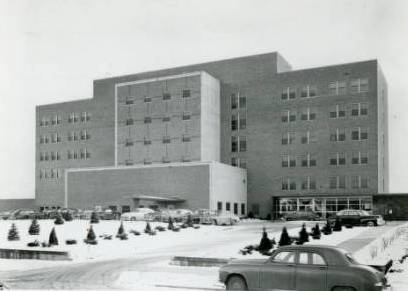
Mount Sinai Hospital
Mount Sinai Hospital, c.1950.
Holding Location
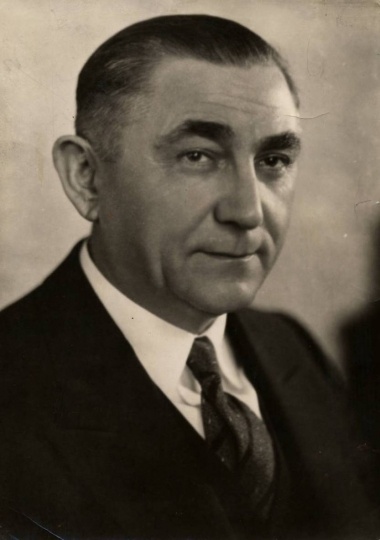
Dr. Moses Barron
Dr. Moses Barron, c.1930. Barron was instrumental in founding Mount Sinai Hospital in Minneapolis.
Holding Location
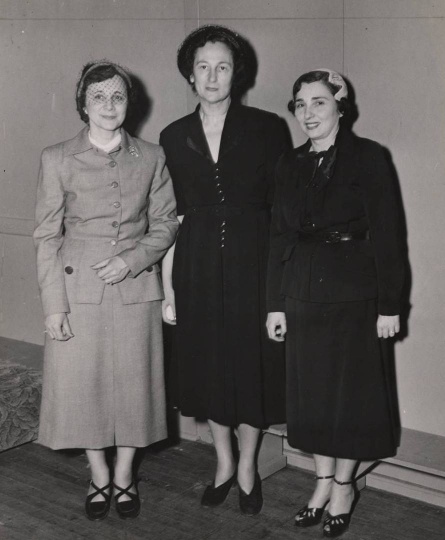
Mount Sinai Hospital Association Auxiliary leaders
Mount Sinai Hospital Association Auxiliary leaders (left to right) Mrs. Louis Gross, Mrs. Charles Penarsky, and Mrs. Sima Meshbesher, 1950.
Holding Location
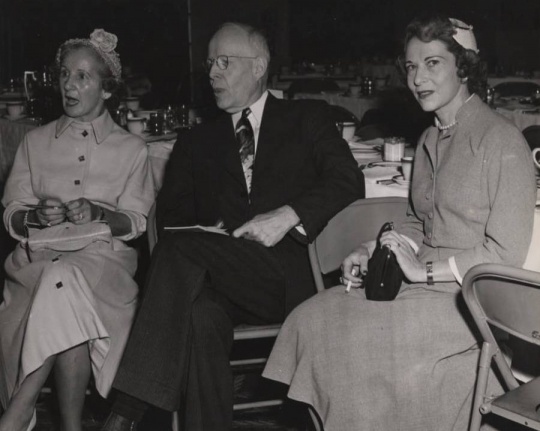
Ruth Melamond, Dr. Owen Wangensteen, and Luella Maslon
Ruth Melamond, Dr. Owen Wangensteen, and Luella Maslon at a Mount Sinai Women's Auxiliary function, 1952. Dr. Wangensteen of University Hospitals was a supporter of Mount Sinai.
Holding Location
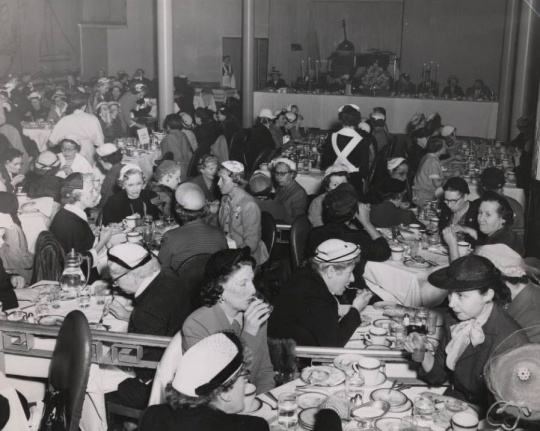
Mount Sinai Auxiliary Luncheon
Luncheon for the Mount Sinai Auxiliary, 1952.
Holding Location
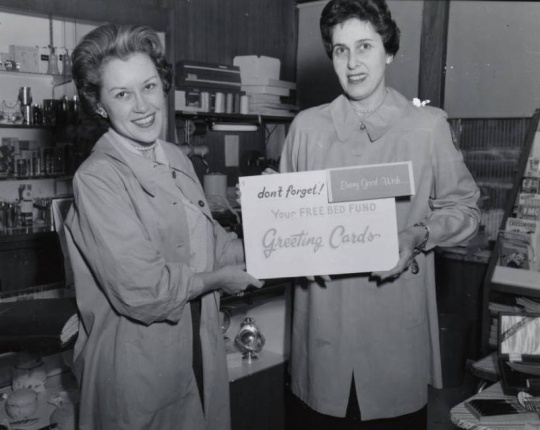
Volunteers at Mount Sinai Gift Shop
Two members of the Mount Sinai Women's Auxiliary posing in the Mount Sinai Hospital gift shop holding a sign advertising greeting cards, c.1954. The Mount Sinai Women's Auxiliary formed a year prior to the opening of Mount Sinai Hospital in 1950. The Auxiliary operated the snack shop and gift cart and provided volunteers offering care to participants and family members.
Holding Location
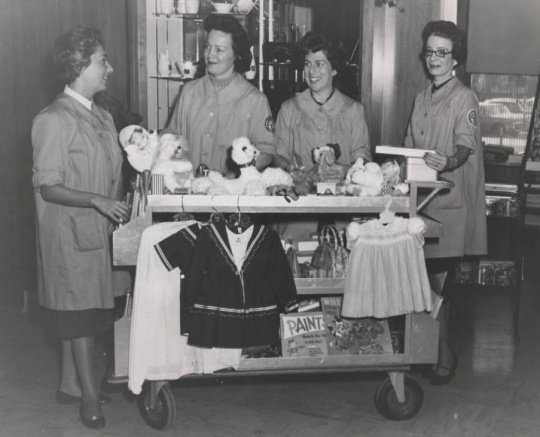
Mount Sinai Hospital Auxiliary workers
Workers from the Mount Sinai Hospital Auxiliary, the hospital’s fundraising, service and public relations organization, 1955.
Holding Location
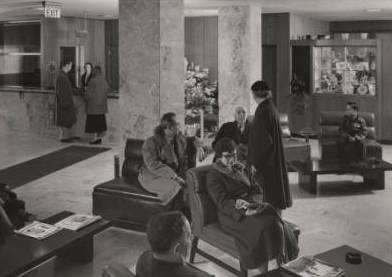
Mount Sinai Hospital Lobby
Interior lobby of Mount Sinai Hospital, 1955.
Holding Location
More Information
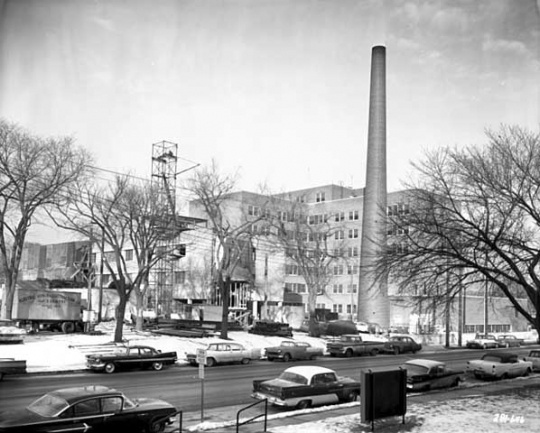
Mount Sinai
Mount Sinai Hospital, 1962.
Holding Location
More Information
Related Articles
Turning Point
After expanding its facilities and entering into a management agreement with Hospital Corporation of America in the 1980s, Mount Sinai Hospital succumbs to market forces and dissolves in 1991.
Chronology
1944
1946
1951
1991
1991
Bibliography
Berman, Hyman, and Linda Mack Schloff. Jews in Minnesota. St. Paul: Minnesota Historical Society Press, 2002.
Gordon, Albert I. Jews in Transition. Minneapolis: University of Minnesota Press, 1949.
Mount Sinai Community Foundation.
http://jewishminneapolis.org/MSCF.aspx
“The Mt. Sinai Community Foundation: A Jewish Legacy of Healing.” YouTube video, 8:01. Posted by “JHSUM Channel,” May 7, 2013.
https://www.youtube.com/watch?v=kyr1S7QrRFw
“Mount Sinai Hospital.” In A Legacy of Pride: American Jewish World: 75 Years. [Minneapolis: American Jewish World, 1986].
umma0003
Mount Sinai Hospital Records
Nathan and Theresa Berman Upper Midwest Jewish Archives, University of Minnesota
Description: Undated typescript titled, “Mount Sinai Short History/Mount Sinai Long History.”
Weber, Laura. “‘Gentiles Preferred’: Minneapolis Jews and Employment 1920–1950.” Minnesota History 52, no. 5 (Spring 1991): 166–182.
http://collections.mnhs.org/MNHistoryMagazine/articles/52/v52i05p166-182.pdf
Related Resources
Primary
Jay Phillips Papers, 1920–1992 (bulk 1944–1992)
Manuscript Collection, Minnesota Historical Society, St. Paul
Description: Papers largely documenting Phillips’ civic and philanthropic activities. The largest portion of the papers deal with Phillips’ work as president and chairman of Mount Sinai Hospital.
P605
Mount Sinai Auxiliary Certificate of Incorporation, 1950
Manuscript Collection, Minnesota Historical Society, St. Paul
Description: Certificate incorporating the Mount Sinai Auxiliary.
Mount Sinai Messenger, 1955–1984
Description: Newsletter published under varying titles by Mount Sinai Hospital and the Mount Sinai Auxiliary.
umma0004
Mount Sinai Hospital Auxiliary Records
Manuscript Collection, Nathan and Theresa Berman Upper Midwest Jewish Archives, University of Minnesota
Description: Contains documents related to the history of the Mount Sinai Hospital Auxiliary.
Pamphlets Relating to Mount Sinai Hospital in Minneapolis, Minnesota
Pamphlet Collection, Minnesota Historical Society, St. Paul
Description: Pamphlets, reports, and printed ephemera relating to Mount Sinai Hospital.
Secondary
Hold Your Head a Little Higher. [Minneapolis: Mount Sinai Hospital Association, 1960].
Lyon, Fred A. Mount Sinai Hospital of Minneapolis, Minnesota: A History. Minneapolis: Mount Sinai Hospital History Committee, 1995.
Plaut, Gunther. The Jews in Minnesota: The First Seventy-five Years. New York: American Jewish Historical Society, 1959.
Phillips Eye Institute, Mount Sinai Hospital: The Premier Center in the Upper Midwest for the Treatment and Surgery of Eye Disorders. [Minneapolis]: N.p., 1987.
Schloff, Linda Mack. “And Prairie Dogs Weren’t Kosher”: Jewish Women in the Upper Midwest Since 1855. St. Paul: Minnesota Historical Society Press, 1996.
——— . “Building Community, Building Bridges: Jewish American Women's Organizations in Minneapolis, 1945-1975.” PhD diss., University of Minnesota, 1995.
——— , ed. Who Knew?: Stories Unearthed from the Archives. Upper Midwest Jewish History 6 (Fall 2011).
http://www.jhsum.org/wp-content/uploads/2010/03/Who-Knew.pdf










